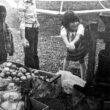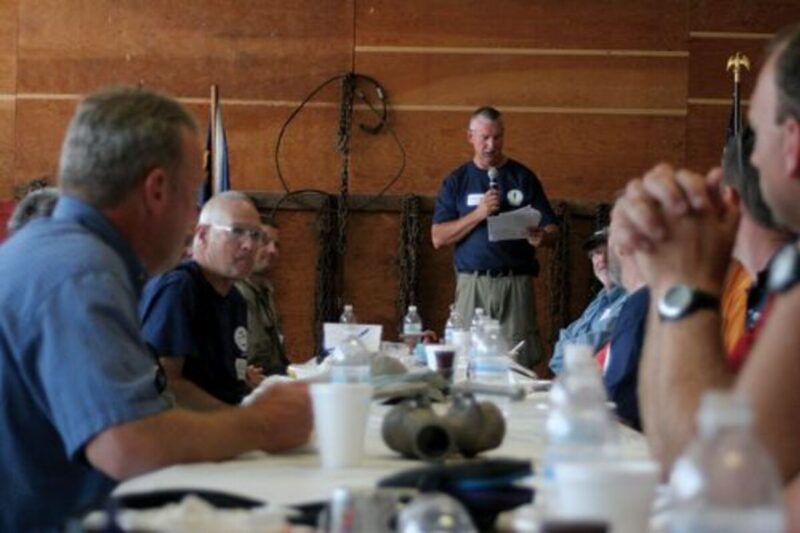Sean C. Morgan
Sweet Home High School wasn’t the only organization celebrating its 100th anniversary last week.
The Linn Forest Protective Association celebrated its 100th birthday on July 11 at the Oregon Department of Forestry Sweet Home Unit. Nearly 100 attended the lunch provided by Denim and Pearls catering. On hand were the LFPA’s two newest engines and the Weyerhaeuser helicopter.
The LFPA works with the ODF to provide fire suppression service to about 1.3 million acres of private and public forestland in the South Cascades District, of which the Sweet Home Unit is a part. The LFPA itself covers approximately 500,000 acres.
“This was just one of the most enjoyable opportunities with my career to date,” said former District Forester Paul Bell. “This is just one of those true partnerships that just goes on and on and makes things successful.”
A Willamette Valley club 18 and under player shoots against Bend during the Nike Open Water Tournament last week.
“The harmony that sits around the board of directors is the heart and soul of the system,” said Mike Dykzeul of the Oregon Forest Industries Council. “You have a capacity of your own you can bring to bear to minimize loss.”
The relationship between the association members and the ODF in Linn County sets a standard for other forest protective associations, he said, comments that were echoed by a number of state and local elected officials.
“This is an incredible example of private and public partnerships and private holding public accountable,” said state Rep. Sherrie Sprenger, District 17.
“If we’re not blessed by the timber in this state, I don’t know what could be possibly be more valuable,” said state Sen. Fred Girod, District 9. “You folks are the heart and soul of my district.”
Timber built libraries, schools and other community resources, he said.
“Thank all of you for preventing and protecting what is the citizens of Linn County’s greatest resource,” said Linn County Commissioner Roger Nyquist.
The LFPA’s first fire season was 1912, said Milt Moran, LFPA president. The only fire of any consequence was in April after five days of soaking rain. A crown fire ran through the tops, while underbrush burned with difficulty. It went out of control due to the carelessness of a fire warden.
At the opening of the 1912 fire season, the LFPA had only one lookout with a telephone, Moran said. That was on Hurricane Deck, now called High Deck. The lookout had been built by Linn and Lane Timber Company and the Road Grant Company.
Three more were selected to be rigged with telephones to the valleys below.
Among them were Cleveland Rock, now Snow Peak, connecting Lacomb, the home of the first Chief Forester, John Marrs, to Avery Interest and Mill City.
The second was Green Peter Lookout, the only lookout remaining in operation near Sweet Home. The lookout featured a trail to nearby Bald Peter, which provided the lookout patrolman a “skyline beat” between he two peaks, a successful innovation that was followed by the U.S. Forest Service.
Horse Rock Lookout was partially paid for by Booth Kelly Lumber Company and other Mohawk interests.
More than 20 fires were started by lightning that season, including two that were visible only at night to the lookouts, Moran said. All were promptly extinguished by rangers.
In 1910, a damaging fire had run for two days before being discovered, Moran said, and Marrs reported in 1912 that “telephone lookouts are here to stay.” At that point, the association exclusively owned about 40 miles of telephone lines, all flanked by good horse trails.
“In common with all firefighting organizations, we consider the patrol system our basis and main reliance,” Marrs said. “The personal equation must be considered in all enterprises, but good patrolmen, well directed and cooperating with faithful lookout men, should extinguish practically all fires, especially if they have those two powerful and necessary aids, efficient telephone equipment and good trails.”
Much of the LFPA’s charge of 3 cents per acre was to pay for trail and telephone line construction, Marrs said. “(It) could not be called exorbitant when it is realized that much work should have been done years ago and that the directors can guarantee the expenses for trails and telephones next year will be much less.”
The rate is around $1.30 per acre today.
At the end of the 1912 report, Marrs said, “There is a faction in the state that would like to see the county or state officials take charge of the firefighting machinery. This would sooner or later mean the injection of politics. The surest method to block such a scheme is for the timber owners to thoroughly organize, either in county or local patrols, and demonstrate to the state that they are able to conserve its timber resources.”
Today, there are 12 forest protective associations cooperating with the ODF.
The 1913 report showed 98 member companies representing 261,000 acres, up from 84 in 1912 with only 8,900 acres and a total patrol area of 335,000 acres.
The LFPA started sharing expenses on the southern lookout with timber owners in Lane County and a “speeder patrolman” who followed trains on the Corvallis and Eastern Railroad, paid for jointly by the LFPA and the Clackamas-Marion Association.
The LFPA had 81 miles of phone lines, with assets conservatively estimated at $5,000, total receipts of $4,800 on an assessment of 2 cents per acre. The association had a cash carryover of $74.61.
Louis W. Hill, Oregon Western Colonization Company and Willamette Valley Lumber Company (later Willamette Industries) were accepted as members in 1939.
A new headquarters was built in Sweet Home in 1955.
In 1979, the LFPA contracted with the state forester to assume firefighting responsibilities, and the Linn County State District, part of the ODF, was formed.
In 2004, the Linn County State District became the Sweet Home Unit of the South Cascades District.





